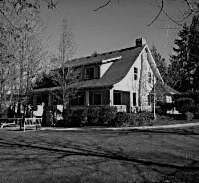Eastside Stories is our way of sharing Eastside history through the many events, people places and interesting bits of information that we collect at the Eastside Heritage Center. We hope you enjoy these stories and share them with friends and family.
Few shoppers trying to negotiate the parking lots and traffic bottlenecks of the Factoria Mall of today—officially Marketplace@Factoria--remember the modest and very useful little shopping center that preceded it in the same spot. In 1949 Swedish immigrant Ole Chellson and his son Henry began construction of their Sunset Super Market in what is today’s mall’s extreme northwest corner. Ole had driven an ice truck for the Leschi Ice Company; now he turned entrepreneur. The Factoria area had been initially logged in the 1890s and platted in 1911 with hopes it would become a major manufacturing center. That dream died early, although in 1927 the old stove factory (the only actual factory that opened at Factoria) was purchased with the expectation that it would become marketing headquarters of a developing rabbit industry on the Eastside. The plant was being equipped to handle fresh and canned rabbit meat and to cure and market the fur.
The Chellsons were in the right spot at the right time, with a clear eye to the future. Ole Chellson had bought his parcel in 1940, just as the Sunset Highway—today’s I-90—east to Issaquah was being straightened and widened to four lanes to be ready for the July 2nd opening of the new Lacey Murrow Floating Bridge across Lake Washington. In 1949 Norwood Village, a community of over 100 homes largely for families of World War II veterans, was being developed across the highway, and on hills to the East, in Horizon View and Hilltop, homes were being built. Eastgate and Lake Hills would arrive within a few more years. A Seattle Times reporter noted that “the Chellsons expect the district will develop even faster when the tolls come off the Lake Washington Floating Bridge.”
Photo (above): Three stores occupying Sunset Shopping Center Shown, Factoria Supermarket, Olive's Sundries, and George Bondo - Realty Priced Right
By December 1950 the Sunset Super Market was open for business, and the following year a second building went up next door, occupied by Olive’s Sundries (Olive was Henry’s older sister) and by George Bondo Real Estate. At some point one of the walls of the grocery held a huge mural, perhaps created by “Mother Chellson,” illustrating life on Lake Washington. On the market’s first anniversary, Ole and Henry advertised in the Mercer Islander a free television set and groceries “to select customers.” Also in 1950 the Sunset Drive-In Theater opened, the venue for the shopping center’s “annual” Easter egg hunt in 1951 for kids under 12 years old.
In 1952 Henry was recalled to the Marines and went off to the Korean War. The grocery was leased out, and to keep himself busy Ole built a gas station in the little complex and operated it for Richfield Oil. Over the years more small businesses were added: a barber shop, Bob Jones Surveyor, and Petersen’s Upholstery Shop. The market got Russ Baker’s Russell’s Meats, and Olive’s Sundries became Maxine’s Café (“a Good Place to Eat” according to local ads) and later Dotty’s Lunch. There was even an electrical service and plant nursery, owned by Nap Nolet. The drive-in theater was a favorite draw. An Issaquah resident who grew up in Hilltop Community recalls that the local teenagers who didn’t want to spend the money for an entry ticket would drive to the hill across the Sunset Highway, near the Unitarian church, and watch the movie from there, even though they couldn’t hear it.
Photo (above): Image of shelves in the Factoria Supermarket stuffed with food. The mural designed by Mrs. Chellson can be seen on the back wall.
But the Eastside’s population was exploding, and the local subdivisions offered their own larger supermarkets and related small businesses. In 1977 the Factoria Square Mall opened right next to and to the South of the drive-in and the little Sunset Shopping Center. Among the three largest stores were a Safeway, an Ernst Home Center and a Pay-n-Save drugstore. Several other buildings held smaller shops. In 1980 a three-theater complex opened at Factoria on the site of the old drive-in. The handwriting was on the wall.
In 1999 Henry Chellson donated to the Eastside Heritage Center a trove of family photos and memorabilia. Unfortunately, the outset of coronavirus has closed access to that collection, and with local libraries and archives still closed, it’s not currently possible to trace the final stages of life of the Sunset Shopping Center. It still lives on in the memories of those current residents who grew up in the Eastside of the 1950s and 60s and for whose families the modest grocery was a godsend, a spot to pick up a quart of milk, loaf of bread, or some fresh meat on the way home from work in Seattle or shopping at Bellevue Square.
Photo (above): In this aerial photograph you can see the back of the drive-screen with the little shopping center buildings laying between the theater and highway 405.















